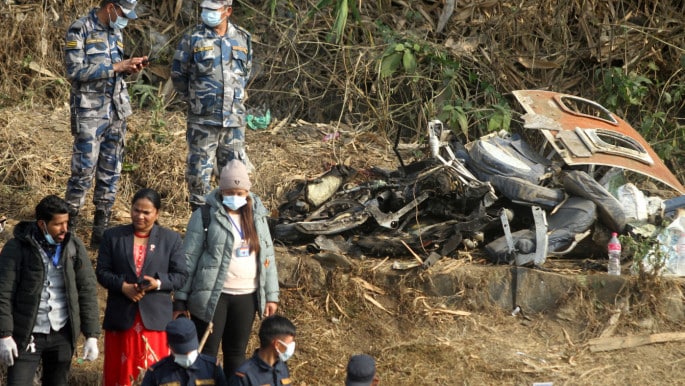Aerospace
Facebook Live Shots from Flyers Sudden Screams, Massive Fire in Nepal Crash

According to reports, an Indian passenger captured the last seconds of the Nepali airliner before it crashed on January 15, killing all 67 persons on board.
The terrifying footage Jaiswal filmed captured flames and passengers’ screams.
The plane, which was traveling from Kathmandu to Pokhara, crashed into a cliff, shattered, and caught fire, killing many people, five of whom were Indian.
Sonu Jaiswal (age 35), Abhishek Kushwaha (age 25), Vishal Sharma (age 22), and Anil Kumar Rajbhar (age 27) were all from the Uttar Pradesh city of Ghazipur.
Sonu Jaiswal and three friends were having a great time sharing their Yeti Airlines flying experience on Facebook Live, exhibiting both interior and exterior views of the aircraft. As the jet crashed, their enthusiasm quickly gave way to horror.
Video (watch here)
A witness who captured the Yeti Airlines plane’s descent on camera said he observed the aircraft flying low before it abruptly veered to the left just before it crashed near Pokhara International Airport in Nepal. Local resident Diwas Bohora, who saw the disaster from his balcony, said he was startled to see the plane nosedive abruptly and initially believed he would perish in the collision.
Local resident Bishnu Tiwari heard calls for help coming from inside the burning wreck when he raced to the scene to assist in the hunt for bodies.
Currently, the flight recorder has been found at the accident site, and an investigation is being conducted. Some of the crash victims have been named and their relatives have been notified.

Aerospace
Boeing Transfers Rocket Stage to NASA, Paving Way for Human Moon Mission

Boeing has achieved a significant milestone by providing NASA with the second core stage of the Space Launch System (SLS) rocket.
This crucial component, crafted at NASA’s Michoud Assembly Facility (MAF), is set to propel the Artemis II crew into lunar orbit, marking humanity’s return to deep space after a 50-year hiatus.
The monumental Boeing-built rocket stage, the largest element of the Artemis II mission, will embark on a journey aboard the Pegasus barge, traveling 900 miles to NASA’s Kennedy Space Center.
Comparison of two legendary aircraft B777x vs B747 aircraft:Click here
Upon arrival, it will be meticulously integrated with other essential Artemis II components, including the upper stage, solid rocket boosters, and NASA’s Orion spacecraft within the iconic Vehicle Assembly Building. This intricate integration process is a vital step toward the eagerly anticipated Artemis II launch, slated for 2025.
“Boeing-built products helped land humankind on the moon in 1969, and we’re proud to continue that legacy through the Artemis generation,” remarked Dave Dutcher, vice president and program manager for Boeing’s SLS program. “Together, with NASA and our industry partners and suppliers, we are building the world’s most capable rocket and paving the way to deep space through America’s rocket factory in New Orleans.”
NASA, Lockheed Martin Reveal X-59 Quiet Supersonic Aircraft:Click here
The delivery of Core Stage 2 marks a significant achievement in the evolution of the SLS rocket. Towering over 200 feet and powered by four RS-25 engines, this core stage, coupled with two solid-fueled booster rockets, will generate a staggering 8.8 million pounds of thrust. This immense power is crucial to launching Artemis II and future missions into the vast expanse of space.
The SLS rocket stands unparalleled in its capability to transport both crew and substantial cargo to the moon and beyond in a single launch. Its extraordinary capacity will facilitate the delivery of human-rated spacecraft, habitats, and scientific missions to destinations including the moon and Mars, ushering in a new era of space exploration.
-

 Travel1 week ago
Travel1 week agoAir India to Expand US Operations with Three New Routes After a Decade
-

 Travel2 weeks ago
Travel2 weeks agoWhy We Should Avoid These Stamps in a Passport
-

 Airlines1 month ago
Airlines1 month agoInvestigations Reveal Fake Chinese Titanium in Boeing and Airbus Jets
-

 Tech4 weeks ago
Tech4 weeks agoChina’s CATL Plans 1,800-Mile Electric Plane Launch by 2027
-

 Airport3 days ago
Airport3 days agoTop 10 Largest Airports in the World by Size
-

 Aerospace4 weeks ago
Aerospace4 weeks agoChina’s Fighter Jets Turn Wings into Autonomous Drones
-

 Airlines4 days ago
Airlines4 days agoAir India Rolls Out A350s for Delhi-New York JFK and Newark Routes
-

 Defence3 weeks ago
Defence3 weeks agoBoeing Enhances Chinook with New Engines and Block II Upgrades at $96 Million







